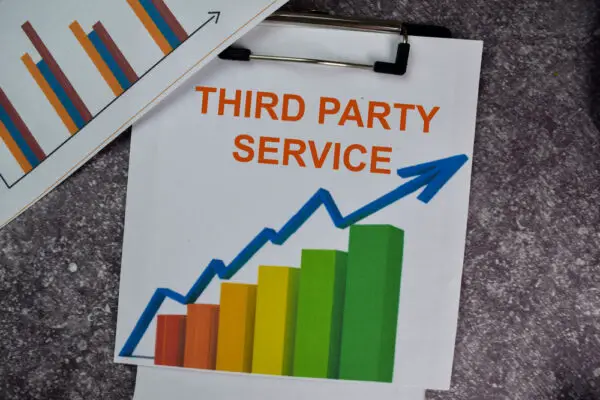Third-party risk refers to an organization’s potential threats when it outsources aspects of its business to external vendors or service providers. These risks can include data breaches, non-compliance with regulations, financial instability, and reputational damage. Here are some steps to manage third-party risk:
Identify Third-Party Relationships: The first step in managing third-party risk is identifying your organization’s third-party relationships. This includes vendors, service providers, contractors, and any other external entities your organization operates with.
Assess Risk: Once you’ve identified your third-party relationships, assess the potential risks associated with each one. This can involve evaluating the third party’s financial stability, compliance with relevant regulations, data security measures, and any other factors that could pose a risk to your organization.
Conduct Due Diligence: Conduct thorough due diligence before entering into a relationship with a third party. This can involve checking the third party’s references, reviewing their financial statements, and verifying their compliance with relevant regulations.
Establish Controls: Implement controls to manage third-party risk. This can involve establishing contract terms, monitoring the third party’s performance, and implementing data security measures.
Monitor and Review: Regularly review your third-party relationships to ensure they meet your organization’s needs and do not pose an undue risk. This can involve regular audits, performance reviews, and risk assessments.
Develop a Contingency Plan: Have a plan for what to do if a third party fails to meet its obligations or poses a risk to your organization. This could involve finding a new vendor, implementing backup systems, or taking legal action.
Train Your Staff: Make sure your staff are trained in third-party risk management. This can help ensure that they understand the risks and know how to manage them.
Third-party vendors are essential to many businesses, providing services and products that enable companies to operate smoothly.
However, increasing reliance on third-party vendors increases the risk of data breaches, cyber-attacks, and other security threats.
Companies must take proactive steps to manage these risks and protect their operations.
Effective third-party risk management involves thorough due diligence, contract implementation, performance monitoring, contingency planning, and regular policy review.
By implementing these strategies, companies can mitigate the risks associated with third-party relationships and safeguard their business operations.
This article will explore these strategies in more detail and provide actionable tips for effective third-party risk management.
Conduct Thorough Due Diligence
Thorough due diligence should be conducted as a standard practice to manage third-party risk effectively. Due diligence involves investigating and evaluating a potential business partner or vendor before entering a relationship.
The diligence process involves gathering information about the organization’s financial stability, reputation, legal history, compliance with regulations, and other relevant factors that could impact its ability to deliver on contractual obligations.
Conducting thorough due diligence enables organizations to identify any potential red flags or risks associated with working with a particular third party. The approach helps businesses avoid costly mistakes such as compliance violations, reputational damage, or financial loss.
Moreover, due diligence is not just a one-time task but an ongoing process throughout the business relationship. Monitoring third-party vendors is necessary to ensure they meet expectations and adhere to regulatory requirements.
Implement Effective Contracts
Implementing effective contracts is a crucial step in managing third-party risks. It involves defining clear roles and responsibilities for all parties, ensuring compliance with legal and regulatory requirements, and establishing performance metrics and remedies.
Establishing clear roles and responsibilities is imperative for effectively managing third-party risk. When working with third parties, it is important to define who will be responsible for what tasks and ensure that every party understands their role. This helps prevent confusion and misunderstandings, which could lead to risks.
To further emphasize the importance of defining clear roles and responsibilities, a table can be used to illustrate the different areas where each party should have specific responsibilities.
The following table outlines some key areas where responsibility needs to be defined when managing third-party risks:
| Area | Responsibilities |
|---|---|
| Contractual | Protection of data, intellectual property rights, or trade secrets from unauthorized access or disclosure |
| Security | Protection of data, intellectual property rights or trade secrets from unauthorized access or disclosure |
| Compliance | Adherence to regulations or standards such as ISO 27001:2013 Information security management system standards |
| Performance Management | Monitoring performance levels agreed upon in the contract |
| Reporting & Communication | Establishing communication protocols between all parties involved |
Establishing clear roles and responsibilities is critical for successfully managing third-party risks. By defining who will be responsible for various aspects of the partnership in advance, all parties involved can work together more efficiently while minimizing potential risks.
Ensure Compliance with Legal and Regulatory Requirements
Ensuring adherence to legal and regulatory requirements is crucial when working with external partners. Organizations must ensure that their third-party partners comply with all relevant laws and regulations, including data protection laws, anti-corruption legislation, and industry-specific regulations. Failure to do so can result in significant financial and reputational damage.
To ensure compliance with legal and regulatory requirements, organizations should take the following steps:
- Conduct due diligence on potential third-party partners to assess their compliance history.
- Include specific contractual terms that outline the partner’s obligations to comply with applicable laws and regulations.
- Monitor third-party compliance through regular audits and assessments.
Establish Performance Metrics and Remedies
Developing measurable performance metrics and appropriate remedies is crucial for effectively managing the relationship with external partners and ensuring their continued success.
Performance metrics should be established in alignment with the goals and objectives of both parties, providing clear expectations for how each partner will contribute to achieving those goals. Metrics can include quality, delivery times, customer satisfaction ratings, and compliance with legal and regulatory requirements.
In addition to establishing performance metrics, it is also important to establish appropriate remedies in case of non-performance or breaches of contract. Remedies can range from financial penalties to termination of the partnership agreement.
These remedies must be clearly outlined in the contract between the parties and agreed upon by all involved. By having established performance metrics and remedies in place, external partners will clearly understand what is expected of them and what consequences may occur if they do not meet these expectations.
This approach ultimately helps manage third-party risks while fostering healthy relationships with external partners.
Monitor Vendor Performance
Regularly reviewing vendor activities enables organizations to identify potential risks and issues arising from their engagements.
Furthermore, tracking changes in the vendor’s business environment serves as an indicator for assessing their continued capacity to deliver services while maintaining compliance with existing contracts.
Effective monitoring of vendors promotes transparency, accountability, and risk mitigation strategies within the organization’s supply chain management framework.
Regularly Review Vendor Activities
Periodic evaluation of vendor activities is crucial in managing third-party risk. It allows the organization to identify deviations from the agreed-upon terms and conditions, assess compliance with regulations and standards, and determine whether the vendor’s performance meets expectations.
Here are some factors that should be considered when reviewing vendor activities:
- Contractual Obligations: Ensure vendors fulfill their contractual obligations by regularly reviewing service level agreements (SLAs).
- Financial Stability: Monitor vendors’ financial statements to ensure they are financially stable and capable of meeting their obligations.
- Security Controls: Verify whether vendors have implemented adequate security controls to protect sensitive data or systems.
- Compliance Adherence: Assess whether vendors comply with applicable regulations, standards, or industry best practices.
Organizations must establish a comprehensive process for monitoring vendor performance regularly. By doing so, they will be able to identify potential issues early on and take corrective action promptly before it affects their operations negatively.
Furthermore, it enables organizations to build stronger relationships with their vendors and achieve greater transparency in their operations.
Monitor Changes in Vendor’s Business Environment
Regularly reviewing vendor activities is an essential part of managing third-party risks. However, it is not enough to simply conduct periodic reviews and assessments; one must also monitor any changes in the vendor’s business environment.
This includes keeping track of their financial stability, ownership structure, market position, regulatory compliance, and other factors that could impact their services or products.
Monitoring changes in a vendor’s business environment, organizations can proactively identify potential risks and take preventive measures to mitigate them.
For instance, if a vendor changes ownership or management, there is a chance that their priorities may shift, which could affect the quality of service provided or even lead to non-compliance with contractual obligations.
Keeping tabs on such developments and conducting due diligence before engaging with vendors or renewing contracts, organizations can ensure that they work with reputable and reliable partners committed to delivering high-quality services while minimizing risk exposure.
Managing third-party risks requires ongoing vigilance and adaptation to changing circumstances – by regularly reviewing vendor activities and monitoring changes in their business environment – companies can stay ahead of potential threats while building strong partnerships for long-term success.
Track Vendor’s Compliance with Contractual Obligations
Tracking and monitoring the vendor’s compliance is imperative to ensure adherence to contractual obligations. This involves ensuring that the vendor complies with all terms and conditions outlined in the contract, including service level agreements, data privacy regulations, security requirements, and legal and regulatory requirements.
Compliance can be tracked through regular audits and reviews of vendor performance metrics.
To effectively track compliance with contractual obligations, organizations should consider implementing a robust monitoring program that includes the following:
- Regular reviews of vendor performance metrics to identify any deviations from agreed-upon terms.
- Conducting periodic onsite visits or remote assessments to verify compliance with contractual obligations.
- Establishing clear escalation procedures for addressing non-compliance issues.
- Ensuring vendors know their obligations by providing comprehensive training on contractual terms and conditions.
Additionally, a well-designed monitoring program can help build trust between organizations and their vendors by fostering transparency and accountability in business operations.

Establish Contingency Plans
The discussion will cover three key points:
- Identifying potential risks and mitigation strategies.
- Developing a disaster recovery plan.
- Establishing an exit plan.
These steps are essential in preparing for unexpected events that may disrupt operations and cause financial losses or reputational damage.
Identify Potential Risks and Mitigation Strategies
Identifying potential risks and developing mitigation strategies are crucial for effective third-party risk management. One way to identify potential risks is to thoroughly assess the third party’s operations, including their policies and procedures and any past incidents or breaches.
This can help organizations identify areas of weakness that could potentially lead to security or compliance issues.
Once potential risks have been identified, developing mitigation strategies that address each risk individually is important. Here are three important considerations when developing these strategies:
- Take a proactive approach: Organizations should proactively manage third-party risk by identifying and addressing vulnerabilities before they become problems. This can involve regular assessments and audits of third-party vendors and implementing controls such as access restrictions and encryption protocols.
- Engage in continuous monitoring: Third-party relationships are dynamic and evolving to monitor vendor activities. This can include conducting periodic assessments or audits, monitoring vendor performance metrics, or setting up automated alerts for suspicious activity.
- Establish clear communication channels: Effective communication between the organization and its third-party vendors is critical for identifying and mitigating risks in a timely manner. Organizations should establish clear lines of communication with their vendors from the outset of the relationship, including protocols for reporting incidents or breaches, sharing information about security policies and procedures, and addressing any concerns or questions that arise over time.
Develop a Disaster Recovery Plan
Developing a disaster recovery plan is crucial in ensuring third-party vendor resilience and business operations continuity in a disruptive incident. A disaster recovery plan outlines procedures and protocols that must be followed to minimize the impact of an unexpected event, such as natural disasters, cyber-attacks, or data breaches.
The primary objective of developing a disaster recovery plan is to restore critical business functions and keep key stakeholders informed throughout the process.
To develop an effective disaster recovery plan for managing third-party risks, it’s essential to identify potential risks and their impact on business operations. The risk assessment should consider all possible scenarios disrupting normal business operations and its supply chain.
It’s also important to understand the dependencies between different systems and processes within the organization’s ecosystem. Once potential risks have been identified, mitigation strategies can be implemented to reduce their likelihood or severity. These strategies can include backup systems, redundancies, or outsourcing services from multiple vendors.
Planning for potential disasters with a well-designed recovery strategy in place, organizations can mitigate risks associated with third-party vendors while maintaining the continuity of operations even during challenging times.
| Risk | Impact | Mitigation Strategy |
|---|---|---|
| Natural Disasters (e.g., hurricanes) | Physical damage to infrastructure and disruption of supply chain | Deploy backup systems at alternate locations outside affected areas. Establish clear communication channels with all stakeholders during emergencies |
| Cyber-attacks | Loss of data confidentiality/integrity/availability | Implement strict security protocols such as encryption techniques for sensitive information exchange with third parties |
| Data Breaches | Potential loss or theft of confidential information | Regularly monitor networks/systems for unusual activity; Set up firewalls/virus scanning software; Conduct regular training sessions for employees on data protection best practices. |
Establish an Exit Plan
Establishing an exit plan is critical in ensuring business continuity and minimizing the potential impact of unforeseen circumstances when dealing with third-party vendors.
An exit plan outlines the steps to be taken in case a vendor relationship needs to be terminated or if there are any unexpected changes in the vendor’s service delivery. Failure to establish an exit plan can lead to legal disputes, financial losses, damage to reputation, and prolonged disruptions.
To ensure that an effective exit plan is established, there are three key considerations that organizations must take into account.
Firstly, it is important to identify all critical services and functions the vendor provides and determine which ones require immediate replacement if the vendor relationship is terminated.
Secondly, organizations must establish clear communication channels between themselves and their vendors regarding termination procedures and expectations during this process.
Lastly, organizations must ensure access to all relevant information, such as data backups, intellectual property rights, and software licenses, before terminating a vendor relationship.
Regularly Review and Update Policies
Regular reviews and updates of policies regarding third-party risk management are essential to ensure the effectiveness of risk mitigation strategies and maintain stakeholder trust. The dynamic nature of business means that changes can occur rapidly, and new risks may emerge.
Organizations must keep their policies up-to-date with the latest industry practices, regulatory requirements, and internal needs. Regular policy reviews help identify gaps in existing frameworks and enable organizations to address them proactively.
Regularly updating policies ensures that all stakeholders managing third-party risks know about any changes. This includes employees, vendors, suppliers, and customers, among others.
Regular communication about new guidelines or procedures helps reduce confusion around the expectations placed on stakeholders concerning third-party risk management.
Furthermore, reviewing policies regularly allows companies to evaluate their current processes critically. This involves analyzing how well they align with organizational goals and identifying areas for improvement.
Companies must incorporate feedback from various stakeholders in this process to comprehensively understand what works best for them.
Updating policies based on feedback from those who interact closely with third parties enables organizations to improve their overall approach toward mitigating third-party risks effectively without disrupting business operations significantly.
Frequently Asked Questions
What are some common red flags to look out for when conducting due diligence on a potential third-party vendor?
During due diligence on a potential third-party vendor, common red flags to look out for include inadequate financial stability, lack of relevant experience or expertise, questionable legal or regulatory compliance history, and insufficient data protection measures.
How can companies ensure their contracts with third-party vendors adequately protect against potential risks?
To ensure adequate protection from potential risks associated with third-party vendors, companies should draft and enforce comprehensive contracts that clearly outline risk allocation, performance standards, liability provisions, termination clauses, and dispute resolution mechanisms.
What metrics should be used to monitor the performance of third-party vendors, and how often should they be reviewed?
To monitor the performance of third-party vendors, metrics should include compliance with contractual obligations, quality of products/services delivered, and adherence to security/privacy standards. Reviews should occur regularly and be tailored to the level of risk posed by each vendor.
How can companies establish effective contingency plans if third-party vendors fail to meet their obligations?
Effective contingency plans can be established by identifying critical third-party services, establishing clear service level agreements (SLAs), defining escalation procedures, and regularly testing the plan.
Communicating the plan with all relevant stakeholders and reviewing and updating it periodically is essential.
What steps should be taken to ensure that policies for managing third-party risk are regularly reviewed and updated to reflect changes in the business environment?
Regular reviews and updates are necessary to ensure policies for managing third-party risk remain relevant. This should involve assessing changes in the business environment, such as shifts in market conditions or regulations, and identifying potential new risks that may arise from these changes.

Conclusion
Managing third-party risk is an essential aspect of any business strategy. Organizations should conduct thorough due diligence to ensure they partner with reputable vendors aligning with their values and objectives.
Implementing effective contracts that outline expectations, responsibilities, and penalties for non-compliance can mitigate risks associated with third-party partnerships.
Monitoring vendor performance through regular assessments and audits will help identify areas for improvement and potential issues before they escalate. Establishing contingency plans is also crucial if a vendor fails to meet obligations or breaches the contract.
Regularly reviewing and updating policies will ensure that organizations stay up-to-date on emerging risks and regulatory changes.
Managing third-party risk requires a proactive approach prioritizing due diligence, effective contracts, ongoing monitoring, contingency planning, and policy updates.

Chris Ekai is a Risk Management expert with over 10 years of experience in the field. He has a Master’s(MSc) degree in Risk Management from University of Portsmouth and is a CPA and Finance professional. He currently works as a Content Manager at Risk Publishing, writing about Enterprise Risk Management, Business Continuity Management and Project Management.



